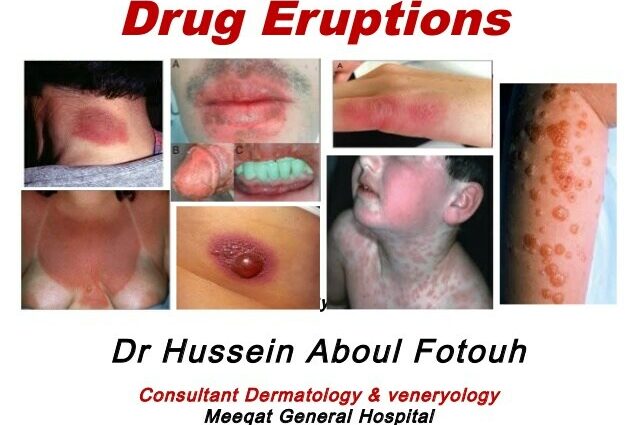Contents
Drug eruption
Drug eruptions include all skin reactions due to the administration of drugs. They account for almost half of side reactions due to drugs.
How to recognize drug eruption?
Drug eruption is a reaction, sometimes allergic, due to the administration of a drug. This reaction causes skin lesions, or dermatoses.
How to recognize the symptom?
Drug eruptions appear differently in each individual. The main consequences are:
- Urticaria
- Itching
- Eczema
- Photosensitivity
- Angioedema and anaphylactic shock
- Alopecia
- Psoriasis
- Acne
- Rash
- Appearance of blisters
- Purpura
- Lichen
- Fever
- Etc …
Risk factors
Commonly used drugs induce drug eruption in 1 to 3% of patients. More than 90% of drug eruptions are benign. The frequency of severe forms (death, serious sequelae) is 2%.
Due to the large difference in symptoms between patients, it is sometimes difficult to diagnose drug eruption. The diagnosis is based on the fact that the appearance of dermatoses coincides with the taking of medication. The disappearance of the symptoms when the drug is stopped and any recurrence after taking the drug again confirms drug eruption.
The causes of drug eruption
Drug eruption always results from taking a drug, whether by skin application, ingestion, inhalation or injection.
Drug eruptions are unpredictable and occur with the usual therapeutic doses. And most drugs can induce these reactions.
However, certain pharmacological products are more likely to cause drug eruption:
- Antibiotics
- Paracetamol
- Aspirin
- Local anesthetics
- Sulfonamides
- D-penicillamine
- The serum
- Barbiturates
- Medicines containing iodine (mainly used in radiology)
- Quinine
- Gold salts
- Griseofulvin
- Antimitotics
Possible complications
Most often drug eruptions are benign but it happens that complications put the patient’s vital prognosis into play:
- Angioedema and anaphylactic shock
- Pustular drug eruption: This is a sudden rash, often mistaken for a serious infection. It usually begins 1 to 4 days after the administration of the inducing drug (often an antibiotic), with fever and a sheet erythema.
- Drug hypersensitivity syndrome: This syndrome is characterized by the severity of the rash, severe itching and high fever.
- Stevens-Johnson and Lyell Syndromes: These are the most serious forms of drug eruption. The reactions begin about ten days after the start of treatment. Scraps of epidermis come off at the slightest pressure. The risk of mortality is high (20 to 25%). But in the event of recovery, re-epidermization is rapid (10 to 30 days) with fairly frequent sequelae: pigmentation disorders and scars.
On the other hand, some patients may present with non-cutaneous complications:
- Digestive disorders such as nausea, vomiting, diarrhea
- Breathing difficulties
- Asthma
- A disruption of the waste disposal function of the kidneys
Treatment
Stopping the drug on medical advice is the main treatment.
It is possible to treat the symptoms of drug eruption until the drug is completely evacuated. So moisturizers can reduce pruritus and antihistamines can calm some itching.
In the most serious cases hospitalization is necessary.
Exceptionally, exhaustive investigations may be prescribed, when a drug absolutely essential to the patient is suspected. Additional examinations then make it possible to determine which exact molecule induces drug eruption.
The reintroduction of new drug must then be done in a medical environment in order to occur with any new drug eruption.










